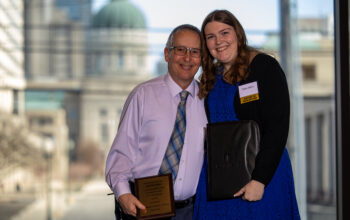By Rick Hinton
It has been written: “When I’m gone, life will proceed to flow around me as though I never existed.”
RANJANI IYER MOHANTY
This may very well be the case on County Road 400, just outside the small Indiana town of Amity in Johnson County. It’s Indiana’s most unusual burial site, and an odd piece of local lore as the grave of Nancy Kerlin Barnett sits literally in the center of the road. Born in 1793, Nancy Kerlin married William Barnett at the age of 14 in 1808. Barnett had a certain amount of prestige, being a descendant of the union of Pocahontas and John Rolfe. Together Nancy and William had 11 children and resided in the then wilderness countryside outside Amity. They foraged an existence, raising their family in this setting and looking toward a future which unfortunately did not happen.

Nancy passed from this life in 1831 at the relatively young age of 39. Life in those times was hard and people would succumb from ailments that we, in this age, can take a pill for and be back on our feet. She loved the area and formed an attachment to the rural setting that was home to her family. Barnett honored her last request, burying her on a small hilltop that overlooked Sugar Creek. Her grave soon became surrounded by the graves of other locals in the community. It was a tranquil spot in the country. There was no County Road 400; that would come later. The years rolled on.
William Barnett drowned in the Ohio River in 1854, some 23 years after his wife’s death. They were not joined in death as most couples plan. You would think the story would end there in that distant realm of the past, but it didn’t. The subject of Nancy’s grave became the subject of much debate and conflict, with two generations of sons taking their stand. The thin footpath that wound through the small country cemetery eventually transitioned into a road. Graves were uprooted and moved to accommodate. Nancy’s son was adamant that his mother’s grave would not be moved. He scored round one! The road skirted her grave and life went on as it should. However, many years later when the county road was widened, things took a different twist. Round two began!

When the road building crews approached this single headstone on the rise of the hill, grandson Daniel Doty was not in the mood for any kind of nonsense – especially that concerning moving his grandmother’s grave. The situation became the fuse on a stick of dynamite. Armed with a shotgun, and often perched on the grave when the crew came to call, there was little room for argument; the road crew left. Who was going to win this battle? Doty’s grave-guarding tactics, along with numerous petitions to county officials, ultimately halted any discussion of her disinterment. The county relented, yet with a subtle twist, rerouted the road around her grave. The years rolled forward as the family gradually dissolved into the past.
On Aug. 8, 1912, a concrete slab was poured over the grave for protection against potential future motor vehicle mishaps, and perhaps, curiosity from the human element. Nancy Kerlin Barnett consequently became sealed into eternity, and the beginnings of myth.

However, it doesn’t end there. …


